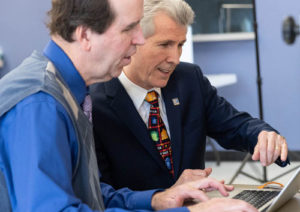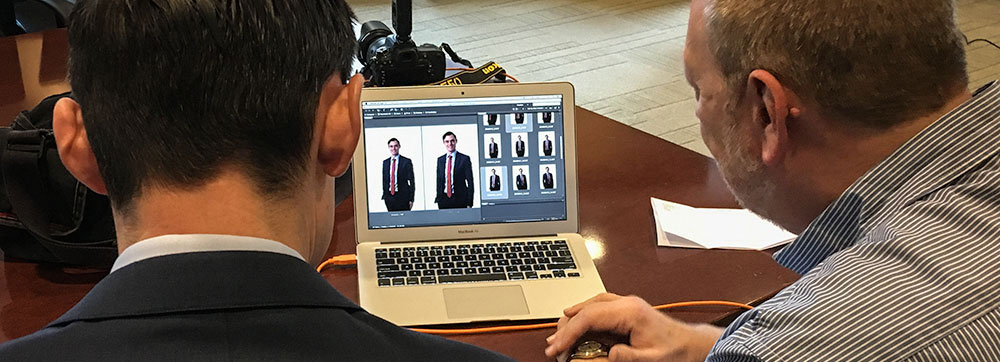I should state right from the beginning that, unlike our colleagues who serve the editorial or advertising markets, in most cases our business portraits are taken without the direct supervision of an art director. We often receive detailed style guidelines from a creative director, but most of the on-site interaction occurs directly between the subject and the photographer.
This means that, under normal circumstances, the subject and the photographer work together at the time of the photo session to arrive at a selected image which is then optimized at our office and sent to our contact for publication. (There are exceptions, such as when we have to photograph a lot of subjects in a short timeframe. This article deals with the more common business head shot portrait assignment in which we have the luxury of 10-15 minutes with each subject.)
How do we make this work?
The majority of our business headshot portraits these days are taken with the camera attached to a portable computer. This allows us to invite the subject to review and select his or her favorite right then, at the time of the photo session. (See ”Why” below.)
We work with a lot of senior-level executives. These executives have important things to be doing, and “picture day” is pretty low on the priority list. Given that we typically have 10-15 minutes with a subject, this means we somehow have to get to a yes in a short period of time. How we get there is as much of an art as is the lighting and the choice of lens.
With rare exceptions, the average subject shows up announcing that he or she would prefer dental surgery over sitting for a business portrait. We get it – it’s awkward and intimidating to stand in front of a stranger while trying to present your ideal persona in a photo which may represent you for years. But by now we have heard this so many times we don’t get discouraged. We bring positive energy to the situation.
Personally, I don't fire away, taking dozens or even hundreds of pictures, hoping that the odds will be with me and at least one will look good.
Usually between 15-20 exposures are enough, with pauses along the way every 6 to 8 shots to evaluate what's happening and allowing for course corrections based on what the subject and I are seeing.
That’s an average of course. For some, as few as 8 is plenty. The most it has ever taken me is 150. (Seriously.)
My colleagues and I at FayFoto Boston do this a lot. We bring confidence and enthusiasm to the situation. And yes, we make flattering and encouraging remarks (“You look good today!”) And yes, we coach the subject (“Shoulders are great, but turn your head a little this way”).

that he or she can have some input on the outcome…
that this experience is a collaboration, a partnership…
that we are here to make her or him look amazing…
a truly palpable change in the energy and relationship emerges.
I have observed that my colleagues prefer to take pictures until they are satisfied they have captured some great images. They then sit with subject to identify the one. Personally, I prefer to start off with fewer preliminary photos and show them to the subject right away, to get a baseline. Either way, the process allows us to experiment with variables such as
- whether to go with our without glasses,
- whether that sweater or wrap works, or
- whether a woman prefers her hair arranged one way or the other.
Why select on-site?
We work with busy professionals. The highly optimized approach described above has evolved over years to meet time and workflow expectations.
- Our contacts are generally keen to get the finished image quickly. Having the selections right away means we can start post production right away.
- Our contacts are not interested in pouring over dozens of options for each subject.
- For most subjects, the motivation to make a selection immediately dwindles to zero when they are given the option of deciding later.
- It is extremely efficient for the subject to select at the time of the session. Contrary to what you might imagine, the best image turns out to be pretty easy to spot.
When it doesn’t work
The process described above works beautifully more than 96% of the time.
But what happens if the subject experiences what I call “decision remorse?”
Or if the subject’s spouse, or mother, or best friend snickers at the selection?
Well, that’s why we never discard anything usable. Blinks and half-blinks are tossed; the rest of the images from an assignment are archived along with the selected images. A proof sheet of additional options from the session can be generated to allow the subject a second chance at deciding. This doesn’t happen often, but it happens often enough that we have learned to keep the out takes.
Get in touch
If this workflow appears to be better suited to your needs than what you are currently experiencing, FayFoto Boston is easy to get in touch with. We would love to have a conversation.

